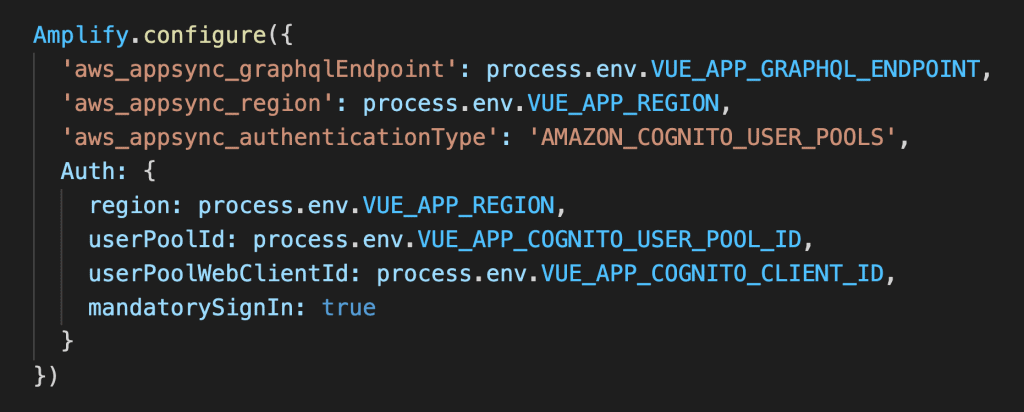
Yan Cui
I help clients go faster for less using serverless technologies.
When you start a new Vue.js project that needs to interface with APIs running in AWS, there’s a good chance you will have these lines of code:
import Amplify from 'aws-amplify'
Amplify.configure({
Auth: {
region: 'us-east-1',
userPoolId: 'xxx',
userPoolWebClientId: 'xxx',
mandatorySignIn: true
}
})
These few lines of code let you use the aws-amplify library to authenticate the user against a Cognito User Pool and support common flows such as sign-up, sign-in, sign-out, forgotten passwords and change passwords.
But, as you provide your Vue.js project across the different environments—dev, test, staging and production—these settings have to change.
So instead of hardcoding them, you should inject them via environment variables. And fortunately for us, Vue.js supports the use of .env files out-of-the-box. However, a caveat that stomped me for a few hours today was that these environment variables need to be prefixed with VUE_APP_.
This was mentioned in the docs but unless you knew what you were looking for, it wasn’t easy to find.
Note that only NODE_ENV, BASE_URL, and variables that start with VUE_APP_ will be statically embedded into the client bundle with webpack.DefinePlugin. It is to avoid accidentally exposing a private key on the machine that could have the same name.
So, you change your code to something like this:
import Amplify from 'aws-amplify'
Amplify.configure({
Auth: {
region: process.env.VUE_APP_REGION,
userPoolId: process.env.VUE_APP_USER_POOL_ID,
userPoolWebClientId: process.env.VUE_APP_CLIENT_ID,
mandatorySignIn: true
}
})
And assuming you’re using the AWS Amplify service to deploy this Vue.js application, you need to configure these as environment variables in the Amplify console.

And pull them into a .env file during the build process. Again, the environment variables in the .env file needs to be prefixed with VUE_APP_.
So, in the amplify.yml file, add these lines to the build phase, just before the npm run build step.
- echo "VUE_APP_REGION=$REGION" >> .env - echo "VUE_APP_USER_POOL_ID=$COGNITO_USER_POOL_ID" >> .env - echo "VUE_APP_CLIENT_ID=$COGNITO_CLIENT_ID" >> .env
Your amplify.yml will probably look something like this.
version: 1
frontend:
phases:
preBuild:
commands:
- npm ci
build:
commands:
- echo "VUE_APP_REGION=$REGION" >> .env
- echo "VUE_APP_USER_POOL_ID=$COGNITO_USER_POOL_ID" >> .env
- echo "VUE_APP_CLIENT_ID=$COGNITO_CLIENT_ID" >> .env
- npm run build
artifacts:
baseDirectory: dist
files:
- '**/*'
cache:
paths:
- node_modules/**/*
Now they’ll be bundled into the app when Amplify builds and deploys it.
Whenever you’re ready, here are 3 ways I can help you:
- Production-Ready Serverless: Join 20+ AWS Heroes & Community Builders and 1000+ other students in levelling up your serverless game. This is your one-stop shop for quickly levelling up your serverless skills.
- I help clients launch product ideas, improve their development processes and upskill their teams. If you’d like to work together, then let’s get in touch.
- Join my community on Discord, ask questions, and join the discussion on all things AWS and Serverless.

